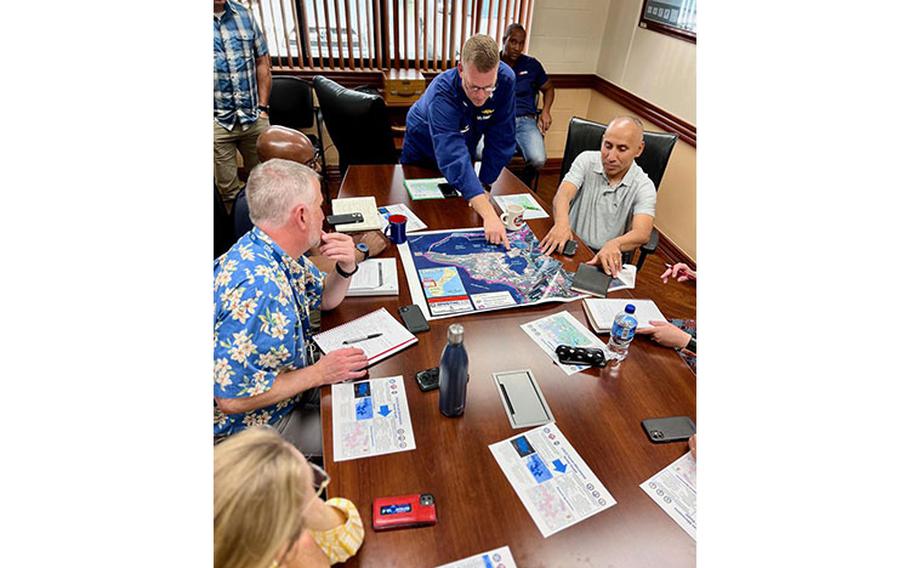Community News
U.S. Coast Guard participates in Guam CNMI Regional Resiliency Assessment Program kickoff
U.S. Coast Guard Forces Micronesia / Sector Guam November 29, 2022

U.S. Coast Guard photo by Chief Warrant Officer Sara Muir ()
SANTA RITA, Guam — U.S. Coast Guard Forces Micronesia/Sector Guam participated in the Guam/CNMI Regional Resiliency Assessment Program (RRAP) visit in Guam the week of Nov. 14.
The U.S. Department of Homeland Security's Cybersecurity and Infrastructure Security Agency (CISA) for Guam and CNMI nominated the Port of Guam and the Commonwealth Ports Authority to receive comprehensive cyber and physical security assessments. While CISA leads the national effort to understand, manage, and reduce risk to our cyber and physical infrastructure, the U.S. Coast Guard has a regulatory role.
"We are pleased to be at the table with our partners as the RRAP for the Port Authority of Guam kicked off," said Capt. Nick Simmons, commander of CGFM/SG. "We know how vital the ports are to our way of life here on Guam, in CNMI, spreading out further into the region. We have strong and valuable relationships with our local and federal government agency partners, the private sector, and non-governmental partners involved in the assessment."
In addition to attending the kickoff conference, CGFM/SG hosted CISA representatives for a talk on regional operations and local efforts.
The RRAP is a voluntary, cooperative assessment of specific critical infrastructure that identifies a range of security and resilience issues that could have regionally or nationally significant consequences.
"Getting these folks around the table, out on site, talking and understanding this region and our challenges is vital to success," said Simmons. "What is on paper back in Washington D.C. may not accurately reflect what we know here, so I applaud these professionals for traveling thousands of miles to see it firsthand and talk to the people with the experience doing the work."
The goal of the RRAP is to generate greater understanding and action among public and private sector partners to improve the resilience of a region's critical infrastructure. To accomplish this, the RRAP:
• Resolves infrastructure security and resilience knowledge gaps; • Informs risk management decisions; • Identifies opportunities and strategies to enhance infrastructure resilience; and • Improves critical partnerships among the public and private sectors.
Each RRAP project typically involves a year-long process to collect and analyze data on the critical infrastructure within the designated area, followed by continued technical assistance to enhance the infrastructure's resilience. Individual projects can incorporate various analytic activities and opportunities for valuable information and data exchanges.
"Cybersecurity and port resilience are on everyone's mind out here. We just hosted Gen. Mark Miles and the Defense Information Systems Agency to illuminate the U.S. Coast Guard mission in the region and inform the team of our conditions and challenges. Miles is the Director for Command, Control, Communications, and Cyber Directorate at U.S. Indo-Pacific Command. DISA hosted a tabletop exercise in Guam to review and assess Guam's critical infrastructure and identify areas for improvement in DoD's communications architecture on the island. The port is absolutely a part of that effort as well. These things dovetail and ultimately impact our resilience, commerce, and defense readiness."
As stated by Indo-Pacific Command, the Defense Department committed about $11 billion in funding for military construction projects in Guam over the next five years and to help ensure Guam remains a place from which the U.S. military can fight, if needed, in the Indo-Pacific region. The port is critical infrastructure to support these projects, in addition to receiving nearly 90 percent of Guam's imports.
The culmination of RRAP activities, research, and analysis will be presented in a Resiliency Assessment documenting project results and findings, including critical regional resilience gaps and options for addressing these shortfalls. Facility owners and operators, regional organizations, and government agencies can use the results to help guide strategic investments in equipment, planning, training, and infrastructure development to enhance the resilience and security of critical infrastructure, surrounding communities, and the entire region.